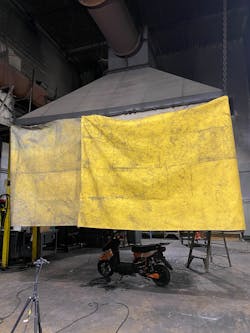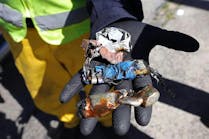Research Corner: Electric Scooter Battery Thermal Runaway & Fire Growth Acceleration
The Fire Safety Research Institute team partnered with researchers from UL Solutions to conduct experiments to quantify hazards that are posed in residences when the lithium-ion (Li-ion) battery of an electric scooter enters thermal runaway. The experiments were motivated by the severe and increasingly frequent fires that are attributed to these vehicles, particularly in New York City.
The experiments set out to answer two questions:
- How fast does occupant tenability become compromised by fires that are started by an e-scooter?
- Are there differences in battery failure behavior for an e-scooter battery that fails by overcharging and by overheating?
The battery packs in the single-passenger e-scooters that were examined for this study were labelled as
60 volt, 20 Ah and featured a 1.2 kWh advertised capacity. There were 136 individual 9 Wh 18650 cells inside of each pack. The battery pack was installed under the seat.
Overheating vs. overcharging
Before exploring whether there are differences between an overcharging failure and an overheating failure, it’s important to understand these two mechanisms for initiating thermal runaway of Li-ion batteries.
The overheating method is reflective of scenarios in which it’s believed that there were defects in cell design that resulted in an internal short circuit. For the overheating experiments, a 10 W/in² electric film heater was applied directly to the outer (exposed) half of five cells in a battery pack. Power was supplied to the heater to drive a steady temperature increase of 6 degrees C/minute. Electrical interconnections and charging circuitry weren’t modified.The overcharging method is reflective of several possible scenarios in which cells aren’t charged in a balanced manner or cell protection or battery pack safety features fail to operate as intended. To intentionally overcharge the batteries, 157 volts were applied directly to the charging cable of the battery pack. The battery management system for the battery pack was bypassed such that an overcharge failure mode could be pursued with reasonable certainty of occurrence and within a practicable amount of time.
To quantify the differences between an overheat- and an overcharge-induced thermal runaway scenario, experiments first were conducted with isolated battery packs in a laboratory. Experiments then were conducted for complete e-scooters in a laboratory and inside of a purpose-built, single-family residential home test prop based on the battery pack experiments. The failure scenario that resulted in the more severe response would be examined in these additional experiments.
For all of the experiments, the Li-ion batteries were initially at 100 percent state of charge from the charger that was supplied by the manufacturer.
Free-burn battery failure
In conjunction with both free-burn battery pack experiments, the pack was placed under an oxygen consumption calorimeter to measure the energy release.
For the overheating experiment, thermal runaway of the battery pack was identified 45 minutes after the start of heat application. There was complete propagation of thermal runaway in the battery pack with peak estimated vertical flame extension of 3–4 feet over a two-minute duration. The peak heat release rate (HRR) was measured at approximately 400 kW.For the overcharging experiment, there also was complete propagation of thermal runaway in the battery pack. Thermal runaway was identified 65 minutes after the start of overcharging. Propagation of thermal runaway lasted for one minute, and flames extended 6–7 feet above the battery pack. The overcharge failure resulted in a higher measured peak HRR of approximately 1,600 kW (1.6 MW).
In both experiments, the battery pack case was deformed from heat and internal pressure rise, and small debris was ejected, but deformation and thermal damage was more severe for the overcharge case.
In-vehicle battery failure
Based on the results from the free-burn battery experiments, it was determined that the remaining set of experiments would utilize intentional overcharging. In this case, the battery pack was installed under the seat, as it would be for typical operation of the e-scooter.
The battery went into thermal runaway approximately 1 hour, 50 minutes after the start of the overcharge. The HRR from the thermal runaway event peaked at approximately 1.1 MW. The HRR decayed to approximately 400 kW. About one minute later, the flaming combustion transitioned from the battery to the foam seat, plastic body panels and fenders of the e-scooter. At this point, a second HRR peak of 1.2 MW was reached. The HRR decayed as the remaining fuel burned out over the next seven minutes.
Of significant concern is the rapidity in fire growth from peak HRR from first flaming. For reference, the 1.1 MW peak HRR is similar to an overstuffed upholstered chair. In this free-burn setting, with no heat feedback that would be experienced in a room environment, the e-scooter reached a peak HRR in 13 seconds. An upholstered chair in a free-burn experiment typically reaches its peak HRR in 2–3 minutes.Battery fire in a compartment
An experiment was conducted in a four-bedroom, two-bathroom, single-story, single-family residential structure that was purpose-built to be a fire test prop. The e-scooter was placed in the entry way of an open concept living room. Thermal runaway was initiated via an intentional overcharge of the battery pack that was conducted identically to the isolated battery and free-burn experiments. All exterior doors and windows were closed; the doors to the first, third and fourth bedrooms were closed; the door to the second bedroom was open prior to the start of the overcharge event.
Thermal runaway occurred approximately 1 hour, 39 minutes after the start of overcharging. Within 10 seconds of sustained visible smoke from the e-scooter, there was transition to flaming combustion. The ignition of the vented smoke caused a sharp pressure rise (approximately
0.2 psi), which resulted in failure of both living room windows, the windows in the second bedroom, the windows in the first bedroom (although the bedroom’s door was damaged and not pressure-tight) and the kitchen doors. Each of these new vents created flow paths with lower-pressure exhaust openings that connected to the higher-pressure fire compartment (living room). Bidirectional flows were established within these flow paths, and additional air was supplied to the fire. As a result, there was flame spread both down the hallway toward the bedrooms and toward the kitchen. Within 40 seconds of visible smoke from the e-scooter, flames were visible out of the failed front and side living room windows. Living room temperature peaked above 2,000 degrees F.
Dangers confirmed
A key takeaway from these experiments is that thermal runaway in large Li-ion batteries can accelerate fire growth significantly and negatively affect the fire response timeline. Although there was effectively unpredictable variability in time to thermal runaway, once thermal runaway was initiated, the HRR from the e-scooters was similar to that of an upholstered chair in substantially less time.
Further compounding the hazard: Pressure rise that’s associated with these failures can compromise fire containment by creating new structure ventilation openings, which facilitates additional flame spread.

Craig Weinschenk
Craig Weinschenk serves as the principal investigator on development of the National Emergency Response Information System (NERIS). His previous research includes full-scale residential fire experiments that were designed to characterize the thermal environment that’s within the structure as well as exposed firefighter PPE. Weinschenk holds a master’s degree and a Ph.D. in mechanical engineering from the University of Texas-Austin.










